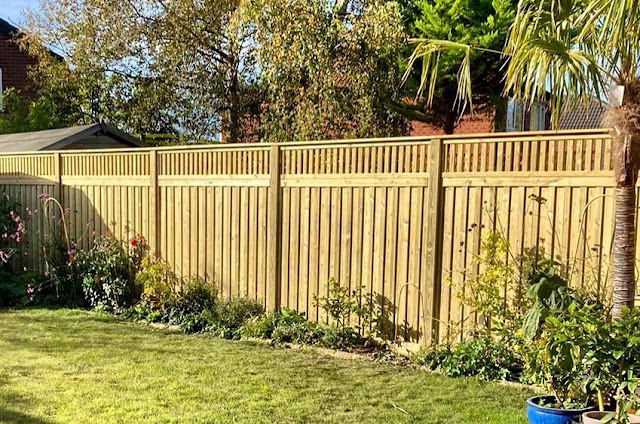Styles of Fence Topper Panels
Fence topper panels are an excellent way to add height, privacy, and decorative flair to an existing fence or wall. Whether you are looking to enhance security, increase privacy, or simply introduce a new design element to your garden, a well-chosen topper panel can completely transform the look of your boundary. In this blog, we explore the different styles of fence toppers available and why quality, framing, and fixings are essential when selecting the right one for your project.
Also read our blog on how fence topper panels work and how they are installed
Popular Styles of Fence Topper Panels
Diamond Trellis Topper
Diamond trellis topper panels feature the classic criss-cross pattern forming diamond shapes. This is one of the most popular styles for softening the appearance of a solid fence without losing a feeling of openness. Diamond trellis toppers are ideal for encouraging climbing plants while maintaining an elegant, traditional look. They also allow light to pass through, keeping gardens feeling bright and airy.
Square Trellis Topper
Square trellis toppers use straight horizontal and vertical battens to create a series of neat square openings. This clean, modern design is perfect for contemporary gardens where sharp, geometric lines are desired. Square trellis toppers add interest to fencing without overwhelming the structure, and they provide the perfect framework for plants like jasmine or ivy.
Lattice Topper
Lattice toppers are similar to diamond trellis but tend to have smaller, tighter gaps. They are particularly useful when you want to add more privacy to an existing fence or wall. Lattice panels combine practicality and decorative appeal, offering a little extra screening while still supporting climbing plants beautifully.
Venetian (Slatted) Topper
Venetian, or slatted, fence toppers are made from horizontal slats with small, even gaps between each board. This design gives a sleek, linear look that works perfectly in modern gardens. Venetian toppers allow light and air to pass through while offering some level of screening and a striking contemporary finish. They are particularly popular for urban gardens where stylish privacy is a key requirement.
Roman Topper
Roman topper panels are a more decorative style, often featuring a gently arched top combined with vertical slats. The Roman design brings an elegant, traditional touch to a fence line and is ideal for gardens where a softer, more classical look is preferred. Roman toppers are great for adding both height and a visual flourish without overwhelming the fencing below.
Metal Topper Panels
Metal decorative topper panels are a stylish alternative to timber and work especially well for adding a contrasting look. The sleek lines and intricate patterns of metal can create a striking visual feature when paired with natural wood fencing, offering a blend of traditional and contemporary design.
Solid Decorative Topper
Some fence toppers are designed to offer a more solid appearance, featuring shaped or profiled designs rather than open trelliswork. This could include panels with curved cut-outs, laser-cut metal inlays, or traditional wooden scrollwork. These styles are ideal if you are looking to add an ornamental feature to your boundary without the need for supporting plant growth.
Fence topper panels are also available in curved shapes, such as convex (arching upwards) or concave (dipping in the middle) designs. These shaped tops can add a flowing, decorative finish to the fence line, although they are slightly less common today as tastes have moved towards simpler, straight-line styles.
Why Quality Matters: Framing, Fixings, and Durability
Just like full-sized fence panels, fence topper panels must be built to last. Choosing a topper that has a solid, robust frame is vital to prevent sagging and warping over time, particularly when exposed to strong winds or the weight of climbing plants.
Stainless steel fixings are highly recommended, as they resist rust and corrosion, ensuring that your panels stay securely fastened for years to come. Investing in quality materials not only improves the appearance of your installation but reduces the need for future maintenance.
If your topper panels are being installed between fence posts, capping rails and post caps can be added for a smart, cohesive finish. These features protect the timber ends from weather damage and provide an extra decorative touch that elevates the overall look of the fence.
It is also important that fence topper panels are not placed in direct contact with the ground. Although they are fitted above a fence or wall, when used creatively as standalone features, it is always advisable to install them above a gravel board if near soil or grass to prolong their lifespan.
Finally, look for topper panels that come with long guarantees, such as 25 years, which indicate that the manufacturer is confident in the quality of the product. A good guarantee offers peace of mind and ensures your investment remains protected for decades.
Toppers Make A Fence Unique
One of the greatest advantages of using fence topper panels is the ability to make any standard fence completely unique. By carefully selecting a topper style that complements your garden design, you can personalise and enhance even the simplest of fencing. Whether you are aiming for a traditional, modern, or highly decorative look, topper panels allow you to create a bespoke finish that reflects your taste and transforms the overall character of your garden.
Fence topper panels are a simple yet highly effective way to enhance the style, privacy, and appeal of any garden boundary. Whether you prefer the traditional charm of diamond trellis, the clean lines of square trellis, the close screening of lattice designs, the contemporary style of Venetian slats, or the classic elegance of Roman toppers, there is a style to suit every setting. Choosing a high-quality, well-framed panel with stainless steel fixings and a strong guarantee will ensure your fencing remains both beautiful and durable for many years to come. With topper panels, you also have the perfect opportunity to put a unique, personal stamp on your garden fencing.







